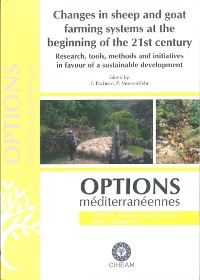| Article précédent | p. 221-225 | Article suivant |
Characterisation of production system of Niza cheese (PDO): effect of sheep breed on milk composition and coagulation properties
The increasing demand for traditional Portuguese cheeses has been promoting structural modifications on sheep milk production system and on traditional cheese making industry with impact on milk properties that are considered to affect cheese quality and tipicity. The objective of this study was to investigate the effect of sheep breed on milk composition and coagulation properties, both being important elements in cheese making, and consequently on cheese quality. The study included two successive winter/spring lactations and monitored three farms, using different sheep breeds, Merino, Saloia and Assaf. The milk of the two daily milkings was sampled twice a month (1st year) or monthly (2nd year), and the samples were analysed for acidity, pH, and solids non-fat, fat, protein and casein contents. The potential cheese making yield was estimated and the milk coagulation properties were assessed using the Optigraph. The milk composition showed higher solids content for Merino and Saloia breeds, resulting in a potential cheese making yield respectively 75 percent and 27 percent higher than Assaf milk. The physical and chemical characteristics contributed also to different milk coagulation behaviour, with superior clot firmness (A40) for Merino breed (16.8 V) and lower values for Assaf sheep milk (13.0 V). The firming rate was also lower for Assaf milk while milk from Saloia showed the fastest clot firming. The results emphasize the different cheese making aptitude of the milk from the autochthonous breeds and suggest the need of technology modifications according to milk characteristics.
La demande croissante de fromages traditionnels portugais a favorisé des modifications structurelles dans le système de production de lait de brebis et dans l'industrie fromagère traditionnelle. L'objectif de cette étude est d'analyser l'effet de la race de brebis sur la composition et l'aptitude à la coagulation du lait, deux éléments importants pour la technologie et la qualité du fromage. L'étude a inclus deux lactations successives hiver/printemps et trois troupeaux de races différentes, Merino, Saloia et Assaf. Le lait des deux traites quotidiennes a été prélevé deux fois par mois (1ère année) ou mensuellement (2ème année). Les échantillons ont été analysés pour l'acidité, le pH, et les teneurs en graisse, protéine et caséine. Le rendement fromager a été estimé et l'aptitude à la coagulation du lait a été évaluée avec l'Optigraphe. La composition du lait a montré un contenu plus élevé de matières solides pour les races Merino et Saloia, ce qui se traduit par un rendement fromager potentiel plus élevé respectivement de 75 pour cent et 27 pour cent que le lait de la race Assaf. Les caractéristiques physiques et chimiques ont contribué également au différent comportement du lait à la coagulation, avec une fermeté de caillé (A40) supérieure pour la race Merino et une obtention de gels plus mous pour le lait d'Assaf. Le taux de raffermissement était également inférieur pour le lait d'Assaf tandis que le lait de Saloia a présenté la gélification la plus rapide. Les résultats mettent en évidence la différence d'aptitude fromagère du lait des races autochtones et suggèrent le besoin de modification de la technologie en fonction des caractéristiques du lait.
- [ Afficher ]
- [ Télécharger ]
- [ Exporter la citation ]
Vous pouvez télécharger la citation au format :
- [ Imprimer ]
-
Mots-clés
BREBIS, COAGULATION, COMPOSITION GLOBALE, FROMAGE DE BREBIS, LAIT DE BREBIS, PORTUGAL, RACE (ANIMAL), RENDEMENTCiter cet article
Martins A.P.L., Belo A.T., Vasconcelos M.M., Fontes A.L., Pereira E.A., Belo C. Characterisation of production system of Niza cheese (PDO): effect of sheep breed on milk composition and coagulation properties. In : Pacheco F. (ed.), Morand-Fehr P. (ed.). Changes in sheep and goat farming systems at the beginning of the 21st century : research, tools, methods and initiatives in favour of a sustainable development . Zaragoza : CIHEAM / DRAP-Norte / FAO, 2009. p. 221-225. (Options Méditerranéennes : Série A. Séminaires Méditerranéens; n. 91). Proceedings of the Seminar of the Subnetwork on Production Systems of the FAO-CIHEAM Network for Research and Development in Sheep and Goats, 2007/11/15-17, Ponte de Lima (Portugal). http://om.ciheam.org/om/pdf/a91/00801149.pdf



